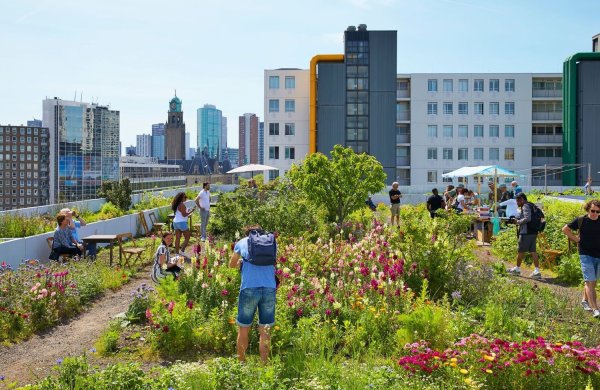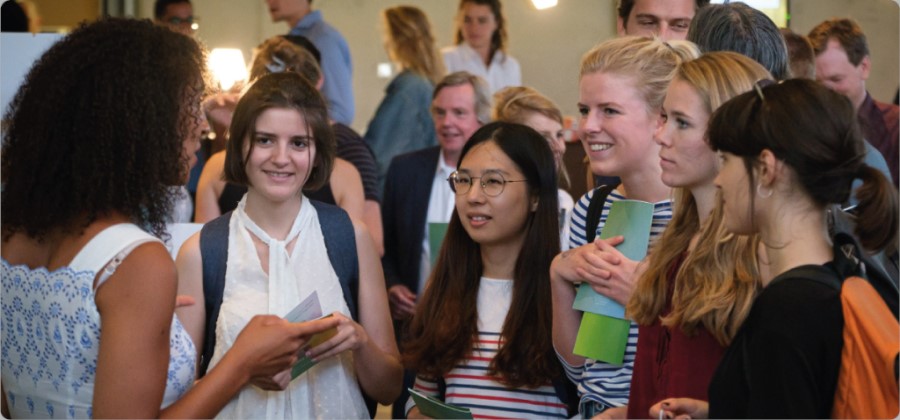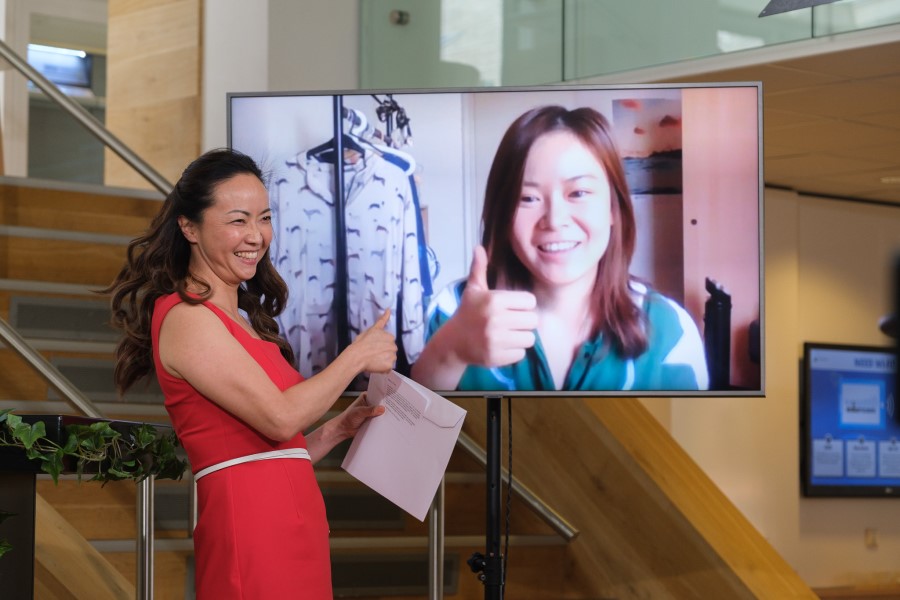
Longread
How WUR Student Challenges help ideas and students grow
Pioneering for a better world attracts many to Wageningen University & Research. For students from all over the globe, a WUR Student Challenge is the ultimate introduction. This innovative educational concept is celebrating its five-year anniversary.
In 2017, to mark its centenary, Wageningen University & Research organised a major international student contest in life sciences for the very first time. Prior to this, there had only been small-scale challenges organised by chair groups. But for its centenary celebrations, the university decided to go big. The WUR Student Challenge was born.
The concept of that first challenge was as follows. Teams of bachelor’s, master’s and PhD students as well as recent graduates from all over the world were able to register for the Urban Greenhouse Challenge. The assignment was to devise an innovative concept for urban agriculture at a specific location, in this case the former Bijlmer prison. The competition ran for seven months and immediately attracted thirty teams, which together accounted for 260 participants.
WUR Student Challenges
| 2017-2018 | Urban Greenhouse Challenge |
| 2018-2019 | ReThink Protein Challenge |
| 2019-2020 | Urban Greenhouse Challenge |
| 2020-2021 | ReThink Protein Challenge |
| 2021-2022 | Urban Greenhouse Challenge |
| 2023 | ReThink Waste Challenge |
| 2023-2024 | Nature-Based Future Challenge |
What started as an idea for an event at an anniversary celebration soon became a plan for an annual phenomenon. The Urban Greenhouse Challenge was followed by a second and a third edition, alternating with another WUR Student Challenge: the ReThink Protein Challenge. The crux of this challenge was to present an idea for how to provide the world with sufficient protein in a sustainable and healthy manner. After five WUR Student Challenges, the counter stands at 212 teams and more than 1,500 participants. It was time for an anniversary party, to be celebrated on 19 October 2022.
Room for own ideas
The difference compared to courses within the regular education programme is huge. Participants in a student challenge have a lot of freedom to develop their own ideas. “You put students behind the wheel,” says Arnold Bregt, Dean of Education. “Didactically, this is education at a higher level.” He is referring here not to the quality of the education, but to the degree of difficulty. Remembering learning material is the lowest level, followed by understanding, applying, analysing and evaluating. Creation, which is what a student challenge is about, is the highest level of education, according to Bregt.
This impacts on how students are guided. “More than anything, we don’t take students by the hand that much,” explains project leader Marta Eggers. “Because of that, it’s mainly the most motivated students who take part.” This was the thinking behind the first WUR Student Challenge. The concept then evolved while the first edition was in full swing.

“It was while the challenge was underway that the ideas emerged for workshops and lectures to help the students,” says Eggers. “We also realised that you need milestones. In the second year, we introduced interim presentations.” Companies also assumed a role as coach from the second edition onwards. What remained the same was that the teams mainly choose for themselves what guidance they want.
Subject pulls students in
Eggers knows that students sign up mainly because they expect to enjoy the assignment. “The main reason is that they are keen to work on a concrete assignment that they can complete entirely in their own way. They need a lot of initiative and creativity to come up with an entry.”
German Fabiola Neitzel participated in the first ReThink Protein Challenge in 2018-2019. “We formed a team of two students. My teammate was in Wageningen for an exchange and saw a flyer. She asked whether I’d like to be involved. I’d been interested in the protein transition for quite a while and thought: Why not?” As a duo, the two never thought they would have a chance against the bigger teams, but slowly their confidence grew. They ultimately won the challenge with their idea of making protein powder from a by-product: the remains of silkworm pupae from India. The powder is intended for use as a supplement in pet food.
Interest from abroad
The international dimension is undoubtedly also an attraction. For the first WUR Student Challenge, half of the teams came from abroad, and since then the overwhelming majority. Now, five years on, the number of universities represented by participating students has risen to 243, spread over 57 countries.

For example, the University of São Paulo in Brazil assembled a team of nine people for the Urban Greenhouse Challenge 2 (2019-2020) after putting out a call to students of Agronomic Engineering and Urban Planning. Camilla Grande Degapari put her hand up, having completed her thesis on vertical agriculture. Her teammate Natália Jacomino was also fascinated with sustainability in agriculture already. But they had an even more important reason for signing up. Both had just returned from an international exchange. And that had whetted their appetite. They chose a WUR Student Challenge as a new international experience.
Out-of-the-box cooperation
The nine team members from São Paolo barely knew each other, did not appear to have all the necessary disciplines covered and were introduced to a university in another country with a different culture. All the while, they were also busy with other parts of their studies. What’s more, during the challenge, Grande Degapari and Jacomino faced yet another new challenging situation as the contest shifted from a competition in person to one that was online due to the outbreak of the pandemic. Grande Degapari: “We are immensely proud that it all worked out. As a team, we came together well, which helped. Working with the whole team was just so much fun.”
Grande Degapari and Jacomino designed a building for urban agriculture and devised a concept called ReThinking the Normal. This symbolised a different way of looking at things, inspired not only by sustainability, but also by changes brought about by the pandemic. And it also refers, probably more unconsciously, to the learning process within the team. “The challenge has taught me to think differently, to wander off the beaten track and to come up with completely new ideas in my current work. We are making cities more circular and helping residents to get ahead,” says Jacomino.
Coaching by companies
Besides the teamwork and the challenging assignment, students appreciate the contact with companies. Over the past five years, 64 different partners from the business community have been involved. Thanks to their engagement, students have been able to expand their network and explore career opportunities. But during the challenge itself, the teams mainly received practical advice from the coaches so that they could flesh out their plan or even adapt it.

Jacomino and Grande Degaspari’s team spoke with a number of coaches, who supplied the knowledge that was still lacking in the team. “They then helped us bring everything together into a well-thought-out plan,” explains Jacomino. Grande Degaspari adds: “For example, after one discussion we realised that we shouldn’t focus on just one crop, but on as many as five or ten different crops. We chose to cultivate outside our building as well.” Neitzel too received useful advice about her business case. “We considerably revised our plan a number of times.”
Advantages for both students and companies
Liz Kamei was a coach for both editions of the ReThink Protein Challenge. She represents Fuji Oil, a driving force behind the production of plant-based proteins. She also offered an extra prize for the idea that best suited her company. As an entrepreneur, she sees great added value in this form of academic education. Kamei: “A challenge for students broadens their view of the world. It shows how academic knowledge can be used in businesses or other organisations.”
Kamei had students from all kinds of backgrounds calling on her. Some were real entrepreneurs, while others were more idealistic. In the conversations, she helped the teams to place their ideas in a business context. “I like to give people something to think about,” she says. “For example, there was a plan to take waste streams from all over the Netherlands and extract protein from them. I asked the team whether they had also included the logistical costs in their final product. They hadn’t taken these into account yet.”
She also bore witness to a whole range of ideas, with the teams from the first edition of the ReThink Protein Challenge using almost exclusively plant-based sources. For the second edition, insects and fungi were represented much more in the plans. Kamei: “It is really interesting to hear all these ideas from young people. This also demonstrates a shift in what is going on in society, in the academic world and in industry. Being involved in these two challenges gave me a better picture of this. As an international company, we have not been in the Netherlands for very long, so this is very useful for us too.”
Putting your idea into practice
After graduating in insect biotechnology, Neitzel started her own company. She used the prize money of 5,000 euro to visit the silk industry in India. She secured a scholarship, which gave her the time to develop her idea further. She has since established her company PROMBYX and is continuing to market the protein powder.

Without the ReThink Protein Challenge, she believes she would never have made it this far. “I wouldn’t have had the courage. The help that we received during the challenge has given me the confidence to keep going. I had never pitched so much, for example. But a challenge like that makes you become a real expert in pitching,” laughs Neitzel. After the challenge, she was also invited everywhere to tell her story. “That encouraged me to continue.”
Two types of challenge
Neitzel is not the only one to decide to further develop her idea, according to Eggers. After the edition which Neitzel was involved in, three teams set up a start-up company. This shows that a contest about the protein transition has a different impact than a contest about urban agriculture. “In the Urban Greenhouse Challenge, the students develop a concept. It’s about the experience and knowledge they acquire. Students can develop their creativity. The ReThink Protein Challenge is about a concrete product, a prototype. Some students then set up a company.”
Just as Kamei saw how the protein transition came to life, so too Eggers witnessed a growing interest among young people in the subject of urban agriculture. “Maybe this is also partly thanks to the Urban Greenhouse Challenge,” she reflects. “We even heard from some students that they were coming to Wageningen to continue their studies because of this challenge.” The subject of urban agriculture is now flourishing so much that the challenge has also been replicated by the University of Bologna in Italy. A former participant in the Wageningen contest helped with its organisation.
New WUR Student Challenges
Five years on, the time was right for WUR to embrace new challenges in line with the themes on which WUR wants to have an impact. The successor to the Urban Greenhouse Challenge is the Nature-Based Future Challenge. ReThink Protein has given way to ReThink Waste. In among the big six-month challenges there are now shorter contests.
5 features of Challenge-Based Learning at WUR
- A real-life problem from an external client or a problem that affects large parts of society
- A complex problem; multiple solutions are possible
- Development of personal and professional skills
- Working in multidisciplinary groups
- Coaches for individual, team and/or process support
These days, it is impossible for the university to imagine life without WUR Student Challenges, according to the Dean of Education, Arnold Bregt. And that is not all. Challenge-Based Learning, the educational concept that also includes the WUR Student Challenges, is also being incorporated into study programmes. “Study programme teams set up the challenges themselves for their students. Unlike the problem-based education that we are very familiar with, Challenge-Based Learning focuses on big issues such as the future of forests in Europe. Within regular education, by the way, there are no prizes to be won with a challenge and the competition element is also often missing. It’s still more about the learning experience than about winning a competition.”
Inspiration for the future
The intention is to enable every Wageningen student to come into contact with this way of learning and thus develop creativity and entrepreneurial skills. “Students learn to make choices and to shape their own learning process in a rich learning environment. What’s more, I see how enthusiastic they are, they experience so much positive energy while working on their idea. That’s incredibly inspiring.” This leads to some ideas coming to fruition and others giving rise to new ideas, according to Bregt. “There’s always something brewing.”